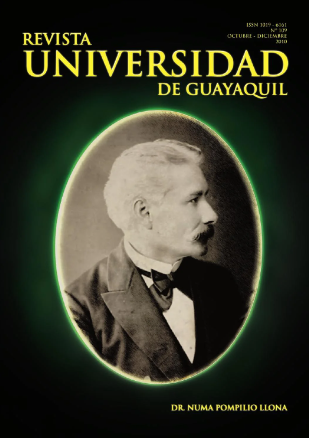Evidence-based medicine. Chronic chagas disease grave, with ventricular aneurysm and their treatment
DOI:
https://doi.org/10.53591/rug.v109i4.371Keywords:
Trichoderma asperellum, Sclerotium rolfsii, horticultural crops, biological control, severity reductionAbstract
Horticultural crops are affected by soil-borne phytopathogens that cause wilting, among them the fungus Sclerotium rolfsii. This phytopathogen reduces yields and contributes to increased production costs due to control measures. The objectives were: 1) To determine the dose of two strains of Trichoderma asperellum on the severity caused by Sclerotium rolfsii in tomato, pepper, and watermelon crops under greenhouse conditions, and 2) To evaluate the methods and times of application of two strains of T. asperellum in these three crops. The dose study treatments were: 1) 5 million spores per plant, 2) 10 million, 3) 15 million, 4) 20 million, 5) 25 million, 6) 30 million spores per plant, 7) Sterile soil, 8) Non-sterile soil, 9) Soil with Captan, 10) Seed with Captan. The application method study had 8 treatments: 1) Applied to the soil surface, seven days before planting, 2) Incorporation into the soil with organic matter and the antagonist seven days before planting, 3) Spraying the antagonist onto the soil seven days before planting, 4) Spraying the antagonist onto the soil seven days after planting, 5) Sterile soil, 6) Non-sterile soil (horticultural field), 7) Soil treated with fungicide, 8) Soil treated with a commercial antagonist. Both experiments were analyzed in a completely randomized design with 10 experimental units. In the dose study, it was determined that 1 x 10^6 conidia of T. asperellum strain G-08 in tomato, pepper, and watermelon crops have an effect in reducing the severity of S. rolfsii infection; on the other hand, strain SE034 with a dose of 15 grams for tomato and pepper crops; in watermelon, 10 grams of substrate. In the application frequency study, T. asperellum strain G-08 for tomato, pepper, and watermelon crops should be applied 7 days before transplanting in liquid form and incorporated with organic matter for preventive treatment and at the first symptoms of the disease for curative treatment, the same procedure should be followed with strain SE034.
References
Agrios, G. 2004. Fitopatología. Editorial Limusa S.A. México. p.192- 515
Carvajal, T. 1997. En Manual de Cultivos Hortícolas. (Estación Experimental Portoviejo). p. 5
Daxl Rainer. 1994. El Manejo Integrado de Plagas. Rossdorf- Alemania. p.25
EL AGRO. 2004. Revista Edición No. 107 Editorial Uminasa S.A. Guayaquil Ecuador. p.17
EL AGRO. 2005. Revista Edición No. 111 Editorial Uminasa S.A. Guayaquil Ecuador. p.51
Fernández-Larrea.O. 2001. Manejo Integrado de Plagas, Avances en el Fomento de Productos Fitosanitarios no Sintéticos, Microorganismos Antagonistas para el Control Fitosanitario, Costa Rica, No. 62 p.96-100.
Hernández L. y Bustamante E. 2001. Control biológico de la marchitez bacterial en tomate con el uso de enmiendas orgánicas. En Manejo Integrado de Plagas, Costa Roca, No. 62 p 18 - 28
Hoitink, H. y Pool, HA. 1980. Factors affecting quality of compost for utilization in container media. Horticultural Science 15:171-173
Nicholls, C. 2008. Control biológico de insectos: un enfoque agroecológico. Antioquia Colombia. p.1.
Sandoval, I., Lopez, M., Bonilla, T. y Oliva, O. 2002. Estudios del biocontrol-- de hongos delsuelo con Trichoderma harzianum y la combinación de la solarización en el clavel (Dianthus barbatus). En XII Congreso Científico Instituto Nacional de Ciencias Agrícolas. La Habana Cuba. Nov.12 al 15 de 2002, p.141.
Reyes, T., Rodriguez, G., Pupo, A., Alarcon, L., Limonta, Y. 2002. Efectividad in vitro de Trichoderma harzianum para el biocontrol de Rhizoctonia solani Kuhn y Pyricularia grisea sacc. aislados en el cultivo del arroz (Oryza sativa L.). Disponible en: www.inisav.cu/fitosanidad/
SICA.2006 Disponible en: http: //www.sica.gov.ec/agro/docs/CUADRO3%20ecuador_estimación_ de_la_superfi%202006.htm
Published
How to Cite
Issue
Section
License

This work is licensed under a Creative Commons Attribution-NonCommercial-NoDerivatives 4.0 International License.

This work is licensed under a Creative Commons Attribution-NonCommercial-NoDerivatives 4.0. International License.
You are free to:
- Share — copy and redistribute the material in any medium or format
- The licensor cannot revoke these freedoms as long as you follow the license terms.
Under the following terms:
- Attribution — You must give appropriate credit , provide a link to the license, and indicate if changes were made . You may do so in any reasonable manner, but not in any way that suggests the licensor endorses you or your use.
- NonCommercial — You may not use the material for commercial purposes .
- NoDerivatives — If you remix, transform, or build upon the material, you may not distribute the modified material.
- No additional restrictions — You may not apply legal terms or technological measures that legally restrict others from doing anything the license permits.































